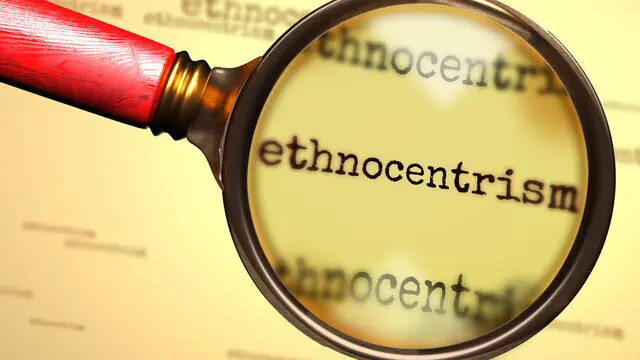As a film critic and cultural analyst, I’ve watched countless movies that attempt to capture the complexities of human nature.
However, few have left as profound an impact on me as Steven Spielberg’s masterpiece, “Schindler’s List.“
This haunting black-and-white film not only depicts the horrors of the Holocaust but also serves as a powerful lens through which we can examine two fundamental aspects of human psychology: egocentrism and ethnocentrism.
In this blog post, we’ll delve deep into how “Schindler’s List” explores these concepts, unraveling the layers of human behavior and challenging us to confront our own biases and prejudices.
Egocentrism and Ethnocentrism
Before we dive into the film’s portrayal, let’s establish a clear understanding of these terms:
Egocentrism
Egocentrism refers to the tendency to view the world primarily from one’s own perspective, often with an inability to recognize or understand viewpoints different from one’s own.
It’s a self-centered worldview that can lead to a lack of empathy and consideration for others.
Ethnocentrism
Ethnocentrism is the belief in the inherent superiority of one’s own ethnic group or culture. It involves judging other cultures based on the standards and values of one’s own, often leading to prejudice, discrimination, and conflict.
The Egocentric Journey of Oskar Schindler
From Self-Interest to Selflessness
One of the most compelling aspects of “Schindler’s List” is its portrayal of Oskar Schindler’s transformation from a self-centered opportunist to a compassionate savior. At the beginning of the film, we see Schindler as the epitome of egocentrism:
- Profit-driven motives: Schindler initially views the war as a business opportunity, caring little for the plight of the Jews.
- Exploitation of the situation: He uses his charm and connections to acquire a factory and cheap labor, focusing solely on his own gain.
- Moral blindness: Schindler turns a blind eye to the suffering around him, compartmentalizing his actions from their consequences.
As the film progresses, we witness a gradual shift in Schindler’s perspective. This transformation challenges the audience to reflect on their own capacity for change and moral growth.
The Turning Point: Empathy Awakens
A pivotal scene that illustrates Schindler’s evolving mindset is when he witnesses the liquidation of the Krakow ghetto.
The sight of a little girl in a red coat (one of the few color elements in the film) becomes a symbol of innocence lost and serves as a catalyst for Schindler’s awakening.
This moment forces Schindler to confront the reality of the situation, pushing him beyond his egocentric bubble. It’s a powerful reminder that often, it takes a personal, emotional connection to shake us out of our self-centered worldviews.
Ethnocentrism: The Dark Heart of Nazi Ideology
The Ultimate Expression of “Us vs. Them”
“Schindler’s List” doesn’t shy away from depicting the extreme ethnocentrism that fueled the Nazi regime. The film shows how this ideology manifests in various ways:
- Dehumanization: The Nazis’ treatment of Jews as subhuman, stripping them of their individuality and dignity.
- Propaganda: The use of media and rhetoric to reinforce the idea of Aryan superiority.
- Systematic oppression: The gradual implementation of laws and practices designed to isolate and eventually eliminate the Jewish population.
Amon Göth: The Face of Ethnocentric Evil
The character of Amon Göth, the sadistic Nazi camp commandant, serves as the embodiment of ethnocentrism taken to its most horrific extreme.
His casual cruelty and complete disregard for Jewish life illustrate the dangers of unchecked ethnocentric beliefs.
One particularly chilling scene shows Göth randomly shooting prisoners from his balcony, treating it as a mundane morning activity. This stark portrayal forces the audience to confront the real-world consequences of extreme ethnocentrism.
The Interplay of Egocentrism and Ethnocentrism
A Toxic Combination
“Schindler’s List” demonstrates how egocentrism and ethnocentrism can reinforce each other, creating a perfect storm of inhumanity:
- Self-justification: Characters like Göth use ethnocentric beliefs to justify their egocentric actions.
- Moral disengagement: Egocentrism allows individuals to distance themselves from the consequences of ethnocentric policies.
- Group dynamics: The film shows how both egocentrism and ethnocentrism can be amplified within a group setting, leading to collective moral failure.
Breaking the Cycle: Schindler’s Evolution
As Schindler moves away from his egocentric worldview, he also begins to challenge the ethnocentric ideology around him.
His decision to save Jewish lives at great personal risk represents a rejection of both egocentrism and ethnocentrism.
This evolution raises important questions for the audience:
- How do our own egocentric tendencies blind us to the suffering of others?
- In what ways might we unconsciously perpetuate ethnocentric attitudes in our daily lives?
- What does it take for individuals to overcome these ingrained psychological tendencies?
Lessons for Today: The Ongoing Relevance of “Schindler’s List”
Recognizing Modern Manifestations
While “Schindler’s List” is set during the Holocaust, its exploration of egocentrism and ethnocentrism remains painfully relevant today. We can see echoes of these attitudes in:
- Political polarization: The tendency to demonize those with different ideological views.
- Xenophobia and nationalism: The rise of anti-immigrant sentiment and extreme nationalist movements.
- Social media bubbles: The creation of echo chambers that reinforce our existing beliefs and biases.
The Power of Individual Choice
Perhaps the most powerful message of “Schindler’s List” is that individual choices matter. Schindler’s transformation shows that it’s possible to overcome our egocentric and ethnocentric tendencies, even in the most challenging circumstances.
As viewers, we’re challenged to examine our own choices:
- How can we cultivate empathy and broaden our perspectives?
- In what ways can we actively challenge our own biases and preconceptions?
- How can we use our individual influence to create positive change in our communities?
Conclusion:
“Schindler’s List” is more than just a historical drama; it’s a profound exploration of human nature and the psychological forces that can lead us towards either cruelty or compassion. By examining how the film portrays egocentrism and ethnocentrism, we gain valuable insights into our own psyche and the world around us.
As we reflect on this masterpiece, let’s challenge ourselves to:
- Regularly examine our own biases and perspective
- Actively seek out diverse viewpoints and experiences
- Stand up against discrimination and prejudice in all its forms
- Remember that small acts of kindness and courage can have far-reaching consequences
In the end, “Schindler’s List” reminds us that the battle against egocentrism and ethnocentrism is not just a historical concern, but an ongoing challenge that each of us must face in our daily lives. By confronting these aspects of human nature, we take a step towards creating a more empathetic and just world.







